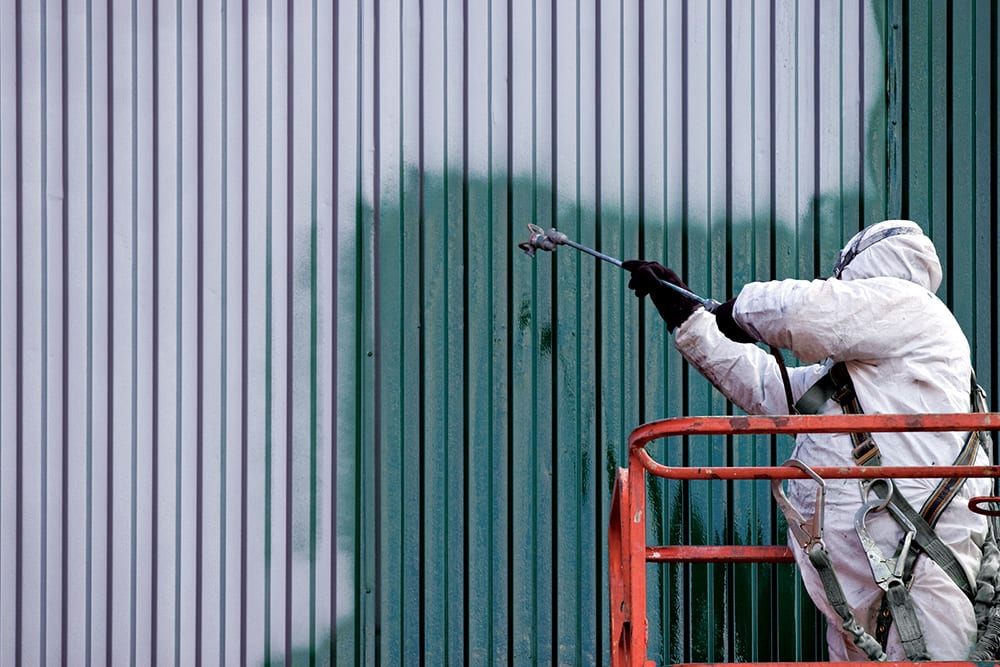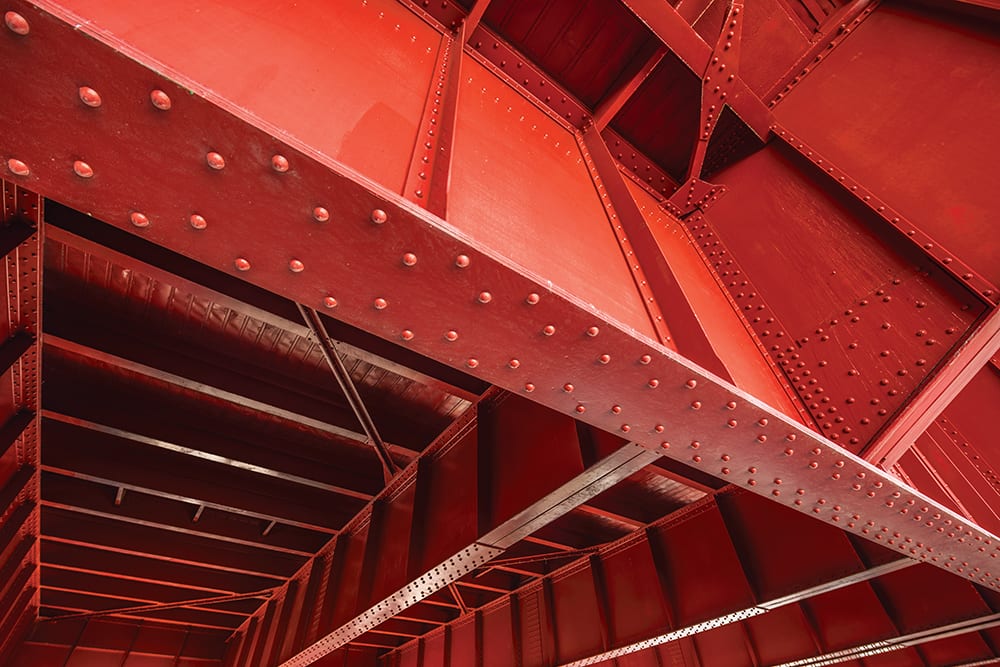By Cynthia Challener, CoatingsTech Contributing Writer
Demand for industrial maintenance coatings, whether on a regional or global scale, generally reflects the health of the economy. Although 2018 was a good year for the sector, the market is not without challenges. Changes in environmental regulations and increasing expectations for greater sustainability and performance at lower cost continue to drive innovation. Despite these hurdles, strong growth is expected in 2019 as raw material suppliers respond with new resin and additive technologies that enable formulators to introduce solutions that meet their customers’ needs.
The global market for industrial maintenance coatings is estimated by consulting firm Kusumgar, Nerlfi & Growney (KNG) in 2018 to be 5.2 billion wet pounds valued at $9.7 billion and growing at 5% annually, according to principle consultant Steven Nerlfi. He notes that growth in this sector depends largely on the economy and the ability to maintain infrastructure within a given country or region. “The industrial maintenance coatings market is highly correlated to GDP growth,” agrees Jon Fedders, North America marketing director at Dow Coating Materials. “Whether it is new infrastructure being built in emerging countries or companies in mature economies allocating budgets for maintenance work, the market sees upticks in demand. Demand boosts also often come in the form of government programs to accelerate infrastructure revamps and renovations. Factoring in all of these trends, we’re very positive about the outlook for 2019 and beyond in North America and globally,” he adds. Spending on deferred maintenance and increased capital investment are indeed current drivers of growth, according to Kyle Kampf, market segment manager, ACE, Marine, & Protective Coatings for BASF.
The fastest growth for industrial maintenance coatings is occurring in Asia-Pacific (6% per year), followed by Central America (3%), NAFTA (2%), and Europe (1–2%), according to KNG. Within the Asia-Pacific region, China accounts for 63% of the volume at nearly 2.0 billion wet pounds valued at $2.9 billion. Solvent-based coatings account for ~85% of the volume and value, but water-based and 100% solids liquid coatings are growing at a much higher rates (17% and 15%, respectively, vs 6% for solventborne).
Strong growth is expected in 2019 as raw material suppliers respond with new resin and additive technologies.
The largest markets in South America are Brazil and Argentina, with Brazil accounting for 81% of the total (145 million wet pounds, $210 million), according to KNG. In Brazil, solvent-based coatings account for 45% of sales and are growing at 3% per year, while water-based and 100% solid systems account for 28% and 8% of the volume, respectively. These segments are growing at 4% and 5% annually.
Water-based coatings have a much larger share of the market in the NAFTA region at 36% of the volume (230 million wet pounds) and 31% of the value ($560 million) and are growing at 4% annually. The 100% solids segment is also growing at 4% per year, but accounts for just 4% of the volume and nearly 7% of the value in 2018. Acrylics and epoxies are the main types of waterborne and 100% solids systems. Of the solventborne industrial maintenance coatings sold in the NAFTA region, epoxies are in greatest demand (30% share), followed by alkyds (32%), and urethanes (19%). “This market segment has experienced a significant uptick and is now in a much better place than it has been since 2014,” states Ronald Brashear, end-use manager Protective Coatings, North America, BYK USA. So far, 2018 has been a good year for industrial maintenance coating growth in North America, agrees Ahren Olson, marketing manager for Protective Coatings at Covestro LLC. “Market conditions for 2019 look good as well, with the oil and gas segment remaining a strong driver for industrial maintenance coatings in both maintenance and new projects,” he observes.
On the other hand, Olson notes that bridge and highway work continues to remain grossly underfunded at the federal level and new legislation is needed to close the funding gap. There is some optimism, however, that some tangible initiatives will begin to materialize in late 2019, which should have further positive impacts on the market in the near term, according to Brashear. Eric Casebolt, market development manager for Eastman Coatings and Inks, sounds a word of caution, though. “We see the market as being healthy but still subject to budgeting challenges when the economy slows and budgets become tighter. There are rarely ‘paint emergencies,’ and paint projects are often the first to be cut when the economy slows and budgets tighten up.”
Europe’s industrial maintenance coatings market in 2018 is expected by KNG to total 710 million wet pounds, valued at $1.8 billion. Solvent-based coatings account for 81% of the volume demand, and include mostly epoxies (42%) and alkyds (23%). Waterborne acrylic and epoxy systems account for 16% of European sales volumes, with 100% solids contributing to 3% of the demand volume in the region.
Demand for industrial maintenance coatings in all other parts of the world is estimated by KNG to be 125 million wet pounds valued at $555 million and growing at 5% annually.
Regardless of the current differences in demand for solvent- and water-based industrial maintenance coatings in the various geographic regions, there are a few common trends driving the development of newer industrial maintenance coating technology around the word: tightening environmental regulations, globalization, and the desire to have simplified product portfolios across all regions, increasing efficiency of the painting process, and reducing cost. “There is a continued need to balance performance, ease of use, and cost,” comments Casebolt. “Many of the coatings in use today have been used for many years, so driving change and adoption of new coatings broadly can be difficult. The main forces for driving change are reducing labor costs and downtime, so ease of application and faster return-to-service can have value,” he says.

More specifically, technology trends today are driven by ease of application, increased durability, and environmental regulations, as well as reduced material usage through thinner film builds and the ability to apply coatings over poorly prepared substrates, according to Kampf. Improving efficiency is typically linked to cost savings, according to Olson. “This has spurred growth in coating systems that can provide adequate corrosion resistance in fewer layers. Direct-to-metal and two-coat polyaspartic coating systems continue to prove their worth in long-term performance and ability to improve painting efficiency vs standard coating systems, with several coating manufacturers launching new polyaspartic coatings in 2017 and 2018,” he says.
Ever-changing VOC regulations are another key driver having direct impact on industrial maintenance coatings. The Ozone Transportation Commission (OTC) states have begun to adopt a new 250 g/L VOC rule (down from 340 g/L), according to Olson. Some industrial maintenance applications may require VOC emission levels as low as 100 g/L or even 50 g/L, such as for commercial architectural applications, according to Fedders. “Environmental and worker health concerns will continue to be key trends impacting development in the industrial maintenance coatings space as we approach 2019,” he observes. Further reduction in the VOC limit to 100 g/L or less would, in fact, force additional coating reformulation and development for solvent-based coatings, according to Olson.
Changes to VOC regulations are not just occurring in mature markets. China is implementing new VOC regulations as well, according to Casebolt. “It is still unclear whether high-solids or waterborne coatings will be the main development target to meet these new Chinese regulations. The ultimate result could be a major factor impacting new coatings/new technology development for China in the short term and technology development globally in the long term,” he asserts.
Perhaps more significant, according to Olson, is the possibility that the exempt status of solvents such as acetone and parachlorobenzotrifluoride will be removed and they will be considered VOCs. “While this change is very unlikely to happen in 2019, it is something that could happen in the next five to 10 years. The impact would be to force the move away from solventborne coatings and the acceptance of water-based systems,” he asserts. Use of exempt and/or non-HAPS solvents does present its own formulation challenges, however, according to Brashear. “Some existing raw materials have limited compatibility in these new systems, which usually manifests itself as lower system performance,” he explains.
Technology trends today are driven by ease of application, increased durability, and environmental regulations, as well as reduced material usage through thinner film builds and the ability to apply coatings over poorly prepared substrates.
Brashear also points to raw materials registrations with regulatory agencies, such as TSCA, DSL, and REACH, as additional drivers of change in industrial maintenance coating technologies. “In some cases, new raw material developments are taking place in order to replace existing materials that have been banned or are in the process of being banned,” he says. He expects this trend to continue for the foreseeable future and pave the way for further developments. Social initiatives such as greenability, sustainability, and renewable content are also driving product innovation, but to a lesser degree, according to Brashear.
Technology changes in response to these performance and environmental expectations are varied. There is an overall trend away from traditional solvent-based alkyd systems and an increased use of hybridized resin systems as a tool to produce higher solids solvent-based systems, according to Brashear. “Epoxy, polyurethane, polyaspartic, and powder systems are emerging as options for 100% solids systems,” he says. Polysiloxanes have also been showing enhanced performance for topcoats, especially with respect to durability, according to Fedders. “With enhanced performance and durability, this technology addresses needs related to longevity of the coating, reduction of layers, and total cost of ownership,” he says.
Given the overall improvements in performance of waterborne binder systems, Brashear adds that many of these systems are now viable options for the formulation of low-VOC coatings, except for those used in the most extreme service conditions. Fedders agrees: “In 2019 and beyond, we expect the industry to accelerate adoption of waterborne technologies in response to the mega trends surrounding safety, environment, and performance. Over the years, technology has developed significantly in waterborne coatings for industrial applications and leading formulators are driving the market to these new technologies.” These changes help to address the needs of safer products for the applicator as well as the environment, according to Brashear.
Epoxy, polyurethane, polyaspartic, and powder systems are emerging as options for 100% solids systems.
Of course, any technology advances designed to meet changing regulatory requirements must continue to provide the same or better performance at the same or lower cost. “Many industrial maintenance coatings are subjected to harsh application conditions, so they not only have to perform well, but they also have to be developed with sustainability, growing government regulations, and cost effectiveness in mind,” Fedders observes. End users, of course, continue to pressure for cost savings even though meeting these requirements can require more expensive raw materials and raw material costs are rising, according to Phil Robinson, market segment manager —General Industrial Resins & Additives at BASF. In addition, he notes, end users also want coatings that are easier to apply, while formulators want raw materials that are easier to manipulate in the manufacturing process.

Next-generation products are, at a minimum, expected to match the application and performance properties of the products that they are replacing, and in many cases provide higher levels of performance, according to Brashear. In addition, he notes that end-use applicators tend to be very sensitive to changes in product performance and are quick to complain about perceived issues with newly formulated products. “Applicators often expect a new product to look, smell, and apply the same as the product it has replaced. Formulators and raw material suppliers alike, however, must also be concerned about the regulatory status of the new raw materials and their impact on formulated systems,” he says. This situation is especially true for multi-national producers and super-regional suppliers who must meet regulatory and registration mandates for many different regions/countries. Coating end users that operate on a global basis want to be supplied the same product in all regions where they operate, according to Olson. “This expectation has pushed coating manufacturers and raw material suppliers to ensure their supply chains can meet this demand across the globe,” he comments.
To meet all of these various market needs, Covestro develops new products that are centered around solving validated market needs to ensure time and resources are spent wisely, according to Olson. For the industrial maintenance market, the company’s focus has been on polyaspartic resin and polyisocyanate technology to provide second-generation products that are more robust and user-friendly than their first-generation counterparts. Resin improvements have increased pot life, lengthened recoatability without having to sacrifice speed of cure, and resulted in better water and corrosion resistance, according to Olson. “These benefits have been validated by both coating applicators and coating manufacturers as these second-generation polyaspartic products have been introduced into the market,” Olson says.
BASF has introduced new resin technologies that address cure control, sustainability, value engineering, protection, and performance market trends, according to Kampf. They include a cost-effective, waterborne direct-to-metal binder technology that offers high corrosion-resistance performance and pot-life indication. “The unique pot-life indicator helps applicators determine the optimal performance window of the formulation,” notes Robinson. BASF has also introduced a higher-solids polyol in an exempt solvent that cures quickly with early hardness yet maintains a long pot life.
Dow Coating Materials recently launched new waterborne resins developed for one-component coatings for direct-to-metal and concrete applications that facilitate formulation of coatings below 50 g/L, according to Fedders. The company also introduced a new acrylic-epoxy hybrid technology for two-component coatings that specifically addresses durability, pot life, and dry time issues associated with epoxies, according to Fedders.
BYK USA has developed two new wetting and dispersing additives that provide for improved performance of aqueous anti-corrosion systems, according to Brashear.
CoatingsTech | Vol. 16, No. 1 | January 2019
